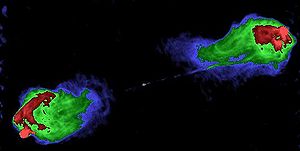- Cygnus A
-
Cygnus A 
Observation data (J2000 epoch) Constellation Cygnus Right ascension 19h 59m 28.3566s[1] Declination +40° 44′ 02.096″[1] Redshift 0.056075 ± 0.000067[1] Distance 600 Mly Type E[1] Apparent dimensions (V) 0.549' × 0.457'[1] Apparent magnitude (V) 16.22[1] Other designations 4C 40.40, 2E 4309, CYG A, W 57, BWE 1957+4035, NRAO 620, 1C 19.01, QSO B1957+405, 3C 405, 1RXS J195928.7+404405, 3C 405.0, 2U 1957+40, 3CR 405, LEDA 63932, 4U 1957+40, VV2000c J195928.3+404402, DA 500, MCG+07-41-003, DB 117, Mills 19+4, VV 72.[1] See also: Galaxy, List of galaxies Cygnus A (3C 405) is one of the most famous radio galaxies, and among the strongest radio sources in the sky. It was discovered by Grote Reber in 1939. In 1951, Cygnus A, along with Cassiopeia A, and Puppis A were the first "radio stars" identified with an optical source, of these, Cygnus A became the first radio galaxy; the other two being nebulae inside the Milky Way.[2] In 1953 Roger Jennison and M K Das Gupta showed it to be a double source.[3] Like all radio galaxies, it contains an active galactic nucleus.
Images of the galaxy in the radio portion of the electromagnetic spectrum show two jets protruding in opposite directions from the galaxy's center. These jets extend many times the width of the portion of the host galaxy which emits radiation at visible wavelengths.[4] At the ends of the jets are two lobes with "hot spots" of more intense radiation at their edges. These hot spots are formed when material from the jets collides with the surrounding intergalactic medium.[5]
Cygnus A appears in Carl Sagan's Contact as the result of beings actively creating a galaxy.
References
- ^ a b c d e f g "NASA/IPAC Extragalactic Database". Results for. http://nedwww.ipac.caltech.edu/. Retrieved 2008-10-01.
- ^ Astrophysical Journal, "Identification of the Radio Sources in Cassiopeia (A), Cygnus A, and Puppis A", Baade, W.; Minkowski, R., vol. 119, p.206, January 1954, doi:10.1086/145812 , Bibcode: 1954ApJ...119..206B
- ^ Jennison, R.C.; Das Gupta, M.K. (1953). "Fine Structure of the extra-terrestrial radio source Cygnus 1". Nature, Vol. 172. p. 996. http://ukads.nottingham.ac.uk/cgi-bin/nph-bib_query?bibcode=1953Natur.172..996J&db_key=AST.
- ^ Strange, D. "The Radio Galaxy Cygnus "A"". http://ourworld.compuserve.com/homepages/dstrange/cygnusa.htm. Retrieved 2008-09-22.[dead link]
- ^ Nemiroff, Robert; Bonnell, Jerry (2002-10-05). "X-Ray Cygnus A". Astronomy Picture of the Day. http://www.sai.msu.su/apod/ap021005.html. Retrieved 2008-09-22.
- Harris, D. E.; Carilli, C. L.; Perley, R. A. X-Ray Emission from the Radio Hotspots of Cygnus-A, Nature Vol. 367, pp. 713, 1994
- "Cygnus A". SIMBAD Astronomical Database. http://simbad.u-strasbg.fr/simbad/sim-id?protocol=html&Ident=Cygnus+A&NbIdent=1&Radius=2&Radius.unit=arcmin&submit=submit+id.
- Blanco, Philip (1997-02-07). "The powerful radio galaxy Cygnus A". http://mamacass.ucsd.edu/people/pblanco/cyga.html.
External links
- Information about Cygnus A from SIMBAD.
- Hubble Uncovers a Hidden Quasar in a Nearby Galaxy (Cygnus A)
Categories:- 3C objects
- Cygnus constellation
- Radio galaxies
- Quasars
Wikimedia Foundation. 2010.
